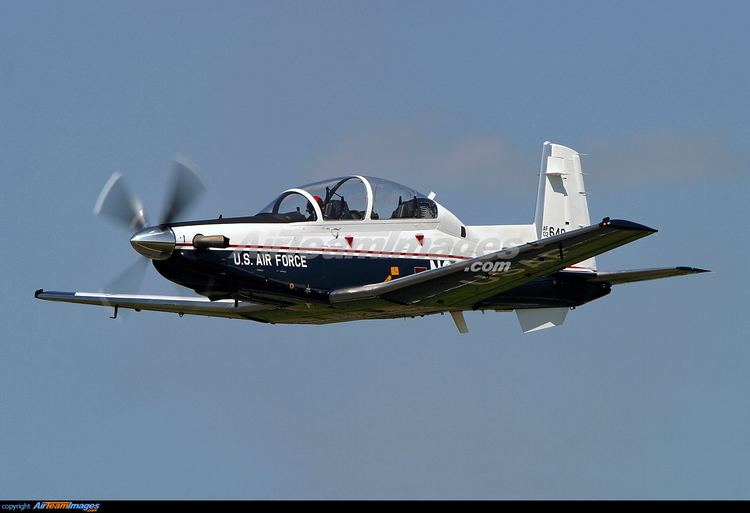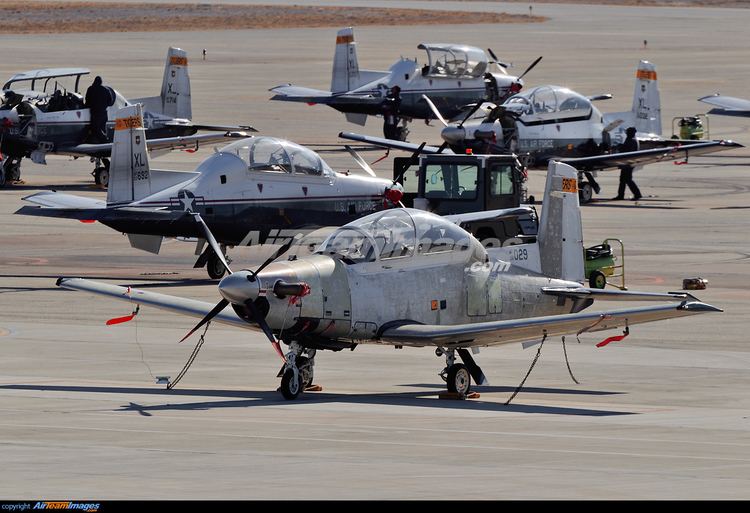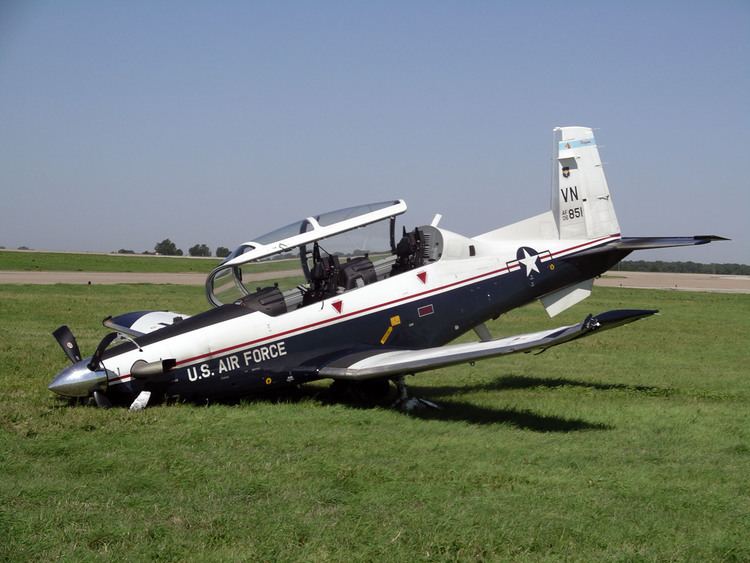Top speed 585 km/h Range 1,667 km Unit cost 3,900,000–6,000,000 USD | Cruise speed 515 km/h Wingspan 10 m | |
 | ||
Engine type Pratt & Whitney Canada PT6 Manufacturers Hawker Beechcraft, Beechcraft | ||
Beechcraft t 6 texan ii turboprop trainer aircraft in us air force basic pilot training us navy
The Beechcraft T-6 Texan II is a single-engine turboprop aircraft built by the Raytheon Aircraft Company (which became Hawker Beechcraft and later Beechcraft Defense Company, and was bought by Textron Aviation in 2014). A trainer aircraft based on the Pilatus PC-9, the T-6 has replaced the Air Force's Cessna T-37B Tweet and the Navy's T-34C Turbo Mentor. The T-6A is used by the United States Air Force for basic pilot training and Combat Systems Officer (CSO) training and by the United States Navy and United States Marine Corps for Primary and Intermediate Naval Flight Officer (NFO) training. The T-6A is also used as a basic trainer by the Royal Canadian Air Force (CT-156 Harvard II), the Greek Air Force, the Israeli Air Force (Efroni), and the Iraqi Air Force. The T-6B is the primary trainer for U.S. Student Naval Aviators. The T-6C is used for training by the Royal Moroccan Air Force, the Royal New Zealand Air Force, and the Mexican Air Force.
Contents
- Beechcraft t 6 texan ii turboprop trainer aircraft in us air force basic pilot training us navy
- Beechcraft t 6 texan ii
- Design and development
- United States
- Canada
- Greece
- Israel
- Iraq
- Mexico
- Morocco
- New Zealand
- United Kingdom
- Variants
- Operators
- Specifications T 6A
- References

Beechcraft t 6 texan ii
Design and development

The T-6 is a development of the Pilatus PC-9, modified significantly by Beechcraft to enter the Joint Primary Aircraft Training System (JPATS) competition in the 1990s. A similar arrangement between Pilatus and British Aerospace had also been in place for a Royal Air Force competition in the 1980s, although that competition selected the Short Tucano. The aircraft was designated under the 1962 United States Tri-Service aircraft designation system and named for the decades-earlier T-6 Texan.

The JPATS competition-winning design was based on a commercial off-the-shelf Pilatus PC-9, with minor modifications. Additional requirements and conflicts between the Air Force and the Navy resulted in delays, cost increases (from initial estimates of $3.9 to roughly $6 million per aircraft), and a completely new aircraft that is 22% or 1,100 lbs heavier than the Pilatus.

On 9 April 2007, the U.S. Department of Defense released their Selected Acquisition Reports, which reported that the T-6 JPATS program was one of only eight programs cited for Congressional notification for 25–50% cost overrun over initial estimates, which is referred to as a "Nunn-McCurdy Breach" after the Nunn-McCurdy Amendment. It is unusual for a program so far into full-rate production to experience significant enough cost overruns to trigger this congressional notification.
United States

The T-6A was introduced to Moody Air Force Base and Randolph Air Force Base in 2000–2001, and the Air Force awarded the full-rate T-6 production contract in December 2001. Laughlin Air Force Base began flying the T-6 in 2003 where it is now the primary basic trainer, replacing the T-37. Vance Air Force Base completed transitioning from the T-37 to the T-6 in 2006. That year, Columbus Air Force Base began its transition, and retired its last T-37 in April 2008. The last active USAF T-37Bs were retired at Sheppard Air Force Base in the summer of 2009.

The Texan failed to qualify for the Light Attack/Armed Reconnaissance program, because the USAF mailed the exclusion notice to the wrong address, leaving the company with no time to protest the decision. But the official mail failure gave Hawker-Beechcraft a further legal justification, as they had told the USAF they planned to file a legal challenge even before the official notice had been mailed and brought its considerable political influence to bear against the USAF decision against their candidate with one Kansas Congressman stating, "It is simply wrong for the Obama administration to hire a Brazilian company to handle national security when we have a qualified and competent American company that can do the job." In 2013, Beechcraft was once again the loser.
Canada
The CT-156 Harvard II is a variant used for pilot instruction in the NATO Flying Training in Canada (NFTC), located at 15 Wing, Moose Jaw, Saskatchewan. They are leased to the Royal Canadian Air Force by the program's administrator, CAE. NFTC's Harvard II aircraft are almost identical in cockpit layout and performance to the American JPATS Texan IIs. Within NFTC, students fly the Harvard II in Phase 2 and 3 of the training program, and some will go on to fly the CT-155 Hawk jet trainer also used by NFTC for Phase 4 (Moose Jaw) and Phase 5 Fighter Lead-In Training (4 Wing, Cold Lake, Alberta). NFTC had 25 Harvard II aircraft owned and maintained by Bombardier, although one was lost following a non-fatal crash in 2011. CAE took over the program in 2015.
Greece
The Hellenic Air Force operates 25 T-6A and 20 T-6A NTA aircraft.
Israel
On 9 June 2008, the Defense Security Cooperation Agency announced a possible FMS sale to Israel of 25 T-6As for the Israeli Air Force. In July 2009, Beechcraft delivered the first four of 20 T-6As under contract to the Israeli Air Force.
Iraq
On 16 December 2009, the first four of 15 T-6A aircraft are delivered to Iraq under a $210 million contract. No AT-6 aircraft were included as was previously reported. This equates to an average of $14 million per aircraft with support and training included. The first eight aircraft, purchased by the Government of Iraq, will arrive at Tikrit by the end of January 2010. The last seven, purchased by the United States, are expected by the end of December 2010.
On 13 May 2014, the US State Department approved an order for 24 T-6C aircraft for use as trainers by the Iraqi Air Force. The sale was worth US$790 million and was part of a larger one billion dollar deal.
Mexico
On 9 January 2012, Mexico purchased six T-6C+ aircraft for the Mexican Air Force to begin replacing their Pilatus PC-7 trainers. On 24 October 2013, Hawker Beechcraft announced a follow-on order of an additional six T-6C+ aircraft for the Mexican Air Force, bringing the total ordered to 12. The Mexican Navy also ordered two T-6C+ Trainers in March 2014.
Morocco
In October 2009, Hawker Beechcraft announced the sale of 24 T-6Cs for the Royal Moroccan Air Force.
New Zealand
The New Zealand Government announced the purchase of 11 T-6Cs for the Royal New Zealand Air Force for NZ$154 million, on 27 January 2014 to replace the PAC CT/4 Airtrainer, with all aircraft delivered by February 2015. The first training course using the type is scheduled for early 2016. The T-6Cs are expected to remain in service with the RNZAF for 30 years.
United Kingdom
On 24 October 2014, the UK Ministry of Defence announced its preferred bidder for the UK Military Flying Training System programme. Ascent's system will involve T-6C Texan IIs in the basic trainer role for both Royal Air Force and Royal Navy pilots. The contract for ten aircraft was signed by Affinity Flying Training Services and Beechcraft Defense on 4 February 2016. The T-6C trainers will replace Shorts Tucano T1 aircraft.
Variants
Operators
Specifications (T-6A)
Data from Global Security, USAF and USN
General characteristics
Performance
